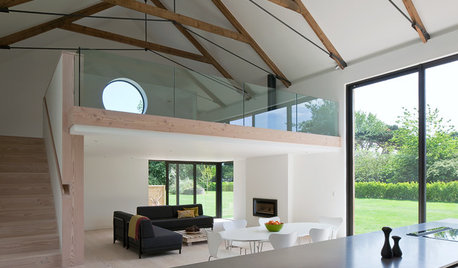Container Tomato Question
dulahey
10 years ago
Related Stories

EDIBLE GARDENSSummer Crops: How to Grow Tomatoes
Plant tomato seedlings in spring for one of the best tastes of summer, fresh from your backyard
Full Story
KITCHEN DESIGN9 Questions to Ask When Planning a Kitchen Pantry
Avoid blunders and get the storage space and layout you need by asking these questions before you begin
Full Story
ARCHITECTUREHouzz Tour: Fresh Ideas in a Former Tomato Packing Shed
A formerly metal-clad structure is now a beautiful wood home designed to capture the light and preserve open space
Full Story
COLOR10 Reasons to Make a Splash With Tomato Red
You won’t duck at these tomatoes. See how bold red shades can play up architecture, light up a dark spot and add drama
Full Story
LIFEKitchen Traditions: Tomato Season Meets a Family Legacy
Somewhere a Sicilian great-great-grandmother is smiling at a bowl of American-made sauce
Full Story
REMODELING GUIDES9 Hard Questions to Ask When Shopping for Stone
Learn all about stone sizes, cracks, color issues and more so problems don't chip away at your design happiness later
Full Story
GREEN DECORATING8 Questions to Help You See Through Green Hype
With the ecofriendly bandwagon picking up some dubious passengers, here's how to tell truly green products and services from the imposters
Full Story
MOST POPULAR8 Questions to Ask Yourself Before Meeting With Your Designer
Thinking in advance about how you use your space will get your first design consultation off to its best start
Full Story
ORGANIZING4 Questions to Help You Organize Your Favorite Photos
Organize your keeper photos with a system that's just right for you, whether it's in the cloud or you can hold it in your hand
Full Story
FEEL-GOOD HOMEThe Question That Can Make You Love Your Home More
Change your relationship with your house for the better by focusing on the answer to something designers often ask
Full Story





luvabasil
dulaheyOriginal Author
Related Professionals
Wrentham Landscape Architects & Landscape Designers · 70037 Landscape Architects & Landscape Designers · Clark Landscape Architects & Landscape Designers · Montgomeryville Landscape Architects & Landscape Designers · Caldwell Landscape Contractors · Hayward Landscape Contractors · Lakewood Landscape Contractors · Metairie Landscape Contractors · Midland Landscape Contractors · North Lauderdale Landscape Contractors · Wilton Landscape Contractors · Fairfax Decks, Patios & Outdoor Enclosures · Foothill Farms Decks, Patios & Outdoor Enclosures · Redlands Decks, Patios & Outdoor Enclosures · Surfside Decks, Patios & Outdoor Enclosuresluvabasil
Okiedawn OK Zone 7
dulaheyOriginal Author
dulaheyOriginal Author
susanlynne48
dulaheyOriginal Author
dulaheyOriginal Author
susanlynne48
Okiedawn OK Zone 7
dulaheyOriginal Author
dulaheyOriginal Author
susanlynne48
dulaheyOriginal Author
susanlynne48